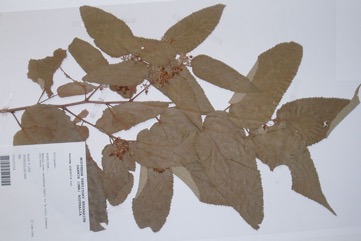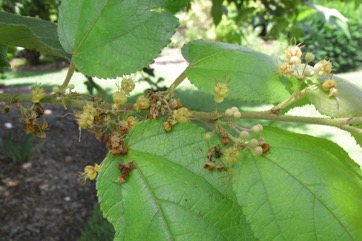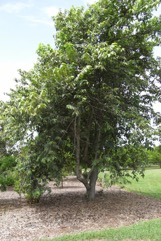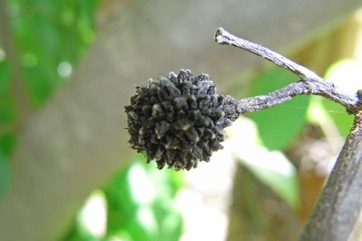West Indian elm

It is a tropical plant. It is native to tropical America. It will grow on poor soils. It grows from sea level to 1,200 m in the tropics. It grows in areas with an annual rainfall below 1,200 mm. It can grow in arid places. Madras. At ECHO.
Also known as:
Acashti, Ajilla, Bay cedar, Bucha, Chico-magro, Cuahulote, Debodaru, Embiru, Guacimo, Guasima, Guasimo, Mutamba, Mutambo, Nepaltunth, Nepal-tuth, Nipaltunth, Pohon jati belanda, Pohon jatilondo, Radraksha, Rudrakscha chettu, Rudrasum, Tenbachai, Thene-chettu, Thenmaram, Tubakki, Udrikpatta, Uttharasham
Synonyms
- Bubroma guazuma (L.) Willd.
- Bubroma tomentosa Spreng.
- Guazuma guazuma Cockerell
- Guazuma tomentosa H. B. K.
- Guazuma utilis Poepp.
- Theobroma guazuma L.
- and others
Edible Portion
- Fruit, Bark - drink, Flowers, Seeds, Gum
Where does West Indian elm grow?
Found in: Africa, Amazon, Antigua and Barbuda, Antilles, Argentina, Asia, Australia, Bahamas, Barbados, Belize, Bolivia, Brazil, Caribbean, Central America, China, Colombia, Costa Rica, Cuba, Dominica, Dominican Republic, East Africa, Ecuador, El Salvador, Gambia, Ghana, Grenada, Guadeloupe, Guiana, Guianas, Guatemala, Guyana, Haiti, Hawaii, Honduras, India, Indonesia, Jamaica, Kenya, Malaysia, Martinique, Mauritius, Mexico, Montserrat, Mozambique, Myanmar, Nicaragua, North America, Northeastern India, Pacific, Pakistan, Panama, Paraguay, Peru, Puerto Rico, Reunion, SE Asia, Seychelles, Sierra Leone, South America, St. Kitts and Nevis, Suriname, Trinidad & Tobago, United States, Venezuela, West Africa, West Indies
Notes: There are 4 Guazuma species in tropical America. Parts of the tree are used in medicine. Also put in the family Sterculiaceae.
Growing West Indian elm
Cultivation: Plants are grown from seed. It is considered that seeds which have passed through an animals digestive tract grow more easily. Seeds are soaked in water at 90°C for 4 minutes then in cool water for 24 hours. Seedlings can be transplanted after 7 months. It can be grown from cuttings.
Edible Uses: The ripe fruit capsule is eaten. The fruit is rich in mucilage. The green fruits are eaten raw, cooked, crushed in water to make a drink or used to flavour other foods. The sap is used to clarify syrup in the making of sugar.
Production: It is fast growing. The fruit remain on the tree for long periods.
Nutrition Info
per 100g edible portion| Edible Part | Energy (kcal) | Protein (g) | Iron (mg) | Vitamin A (ug) | Vitamin c (mg) | Zinc (mg) | % Water |
|---|---|---|---|---|---|---|---|
| - | - | - | - | - | - |
West Indian elm Photos





References
Altschul, S.V.R., 1973, Drugs and Foods from Little-known Plants. Notes in Harvard University Herbaria. Harvard Univ. Press. Massachusetts. no. 2784
Ambasta, S.P. (Ed.), 2000, The Useful Plants of India. CSIR India. p 250
Bandyopadhyay, S. et al, 2009, Wild edible plants of Koch Bihar district, West Bengal. Natural Products Radiance 8(1) 64-72
Bandyopadhyay, S., et al, 2012, A Census of Wild Edible Plants from Howrah District, West Bengal, India. Proceedings of UGC sponsored National Seminar 2012
Bortolotto, I. M., et al, 2015, Knowledge and use of wild edible plants in rural communities along Paraguay River, Pantanal, Brazil. Journal or Ethnobiology and Ethnomedicine. 11:46
Bortolotto, I. M., et al, 2018, Lista preliminar das plantas alimenticias nativas de Mato Grosso do Sul, Brasil. Iheringia, Serie Botanica, Porto Alegre, 73 (supl.):101-116
Burkill, I.H., 1966, A Dictionary of the Economic Products of the Malay Peninsula. Ministry of Agriculture and Cooperatives, Kuala Lumpur, Malaysia. Vol 1 (A-H) p 1133
Casas, A., et al, 1996, Plant Management Among the Nahua and the Mixtec in the Balsas River Basin, Mexico: An Ethnobotanical Approach to the Study of Plant Domestication. Human Ecology, Vol. 24, No. 4 pp. 455-478
Chizmar Fernandez, C., et al, 2009, Plantas comestibles de Centroamerica. Instituto de Biodiversidad, Costa Rica. p 307
Condit, R., et al, 2011, Trees of Panama and Costa Rica. Princeton Field Guides. p 282
Cruz, I. M., et al, 2015, Edible fruits and seeds in the State of Mexico. Revista Mexicana de Ciencias Agricolas. Vol. 6. Num. 2 pp 331-346
Facciola, S., 1998, Cornucopia 2: a Source Book of Edible Plants. Kampong Publications, p 239
Flora of Pakistan. www.eFloras.org
Grandtner, M. M., 2008, World Dictionary of Trees. Wood and Forest Science Department. Laval University, Quebec, Qc Canada. (Internet database http://www.wdt.qc.ca)
Grandtner, M. M. & Chevrette, J., 2013, Dictionary of Trees, Volume 2: South America: Nomenclature, Taxonomy and Ecology. Academic Press p 281
Hedrick, U.P., 1919, (Ed.), Sturtevant's edible plants of the world. p 334 (As Guazuma tomentosa)
Kinupp, V. F., 2007, Plantas alimenticias nao-convencionais da regiao metropolitana de Porto Alegre, RS, Brazil p 80
Kiple, K.F. & Ornelas, K.C., (eds), 2000, The Cambridge World History of Food. CUP p 1820
Krishen P., 2006, Trees of Delhi, A Field Guide. DK Books. p 100
J. B. A. P. M. de Lamarck & L. A. J. Desrousseaux, Encycl. 3:52. 1789
Lira, R., et al, 2009, Traditional Knowledge and Useful Plant Richness in the Tehuacan-Cuicatlan Valley, Mexico. Economic Botany XX(X): 1-17
Lorenzi, H., 2002, Brazilian Trees. A Guide to the Identification and Cultivation of Brazilian Native Trees. Vol. 01 Nova Odessa, SP, Instituto Plantarum p 343
Paz, F. S., et al, 2021, Edible Fruit Plant Species in the Amazon Forest Rely Mostly on Bees and Beetles as Pollinators. Journal of Economic Entomology, XX(XX), 2021, 1–13
Peres, M. K., 2011, Diasporos do Cerrado Atrativos para Fauna: Chave Interativa Caracterizacao Visual e Relacoes Ecologicas. Masters thesis. Universidade de Brasilia.
Plants of Haiti Smithsonian Institute http://botany.si.edu/antilles/West Indies
PROSEA
Reddy, K. N. et al, 2007, Traditional knowledge on wild food plants in Andhra Pradesh. Indian Journal of Traditional Knowledge. Vol. 6(1): 223-229
Royal Botanic Gardens, Kew (1999). Survey of Economic Plants for Arid and Semi-Arid Lands (SEPASAL) database. Published on the Internet; http://www.rbgkew.org.uk/ceb/sepasal/internet [Accessed 11th June 2011]
Segura, S., et al, 2018, The edible fruit species in Mexico. Genet Resour Crop Evol (2018) 65:1767–1793
SHORTT, (As Guazuma tomentosa)
Singh, V. and Singh, P., 1981, Edible Wild Plants of Eastern Rajasthan. J. Econ. Tax. Bot. Vol 2 pp 197-207
Smith, N., et al, 2007, Amazon River Fruits. Flavors for Conservation. Missouri Botanical Gardens Press. p 148
Standley, P. C. & Record, S. J., 1936, The Forests and Flora of British Honduras. (Belize). p 254
Staples, G.W. and Herbst, D.R., 2005, A tropical Garden Flora. Bishop Museum Press, Honolulu, Hawaii. p 544
Sukarya, D. G., (Ed.) 2013, 3,500 Plant Species of the Botanic Gardens of Indonesia. LIPI p 312
Swaminathan, M.S., and Kochnar, S.L., 2007, An Atlas of Major Flowering Trees in India. Macmillan. p 54
Tamil herbs, 2007, Edible Plants of the Tropical Dry Evergreen Forest.
Turreira-Garcia, N., et al, 2015, Wild edible plant knowledge, distribution and transmission: a case study of the Achi Mayans of Guatemala. Journal of Ethnobiology and Ethnomedicine. 11:52
Uphof,
Van den Eynden, V., et al, 2003, Wild Foods from South Ecuador. Economic Botany 57(4): 576-603
van Roosmalen, M.G.M., 1985, Fruits of the Guianan Flora. Utrecht Univ. & Wageningen Univ. p 419
WATT, (As Guazuma tomentosa)
World Checklist of Useful Plant Species 2020. Royal Botanic Gardens, Kew
www.colecionandofrutas.org
www.worldagroforestrycentre.org/sea/products/afdbases/af/asp/SpeciesInfo.asp?SpID=944
Yetman, D., 2002, The Guarijios of the Sierra Madre: Hidden People of Northwestern Mexico. University of New Mexico Press. p 224
Zuchowski W., 2007, Tropical Plants of Costa Rica. A Zona Tropical Publication, Comstock Publishing. p 65